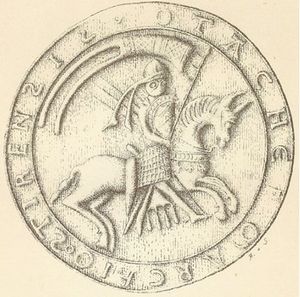Ottokar III of Styria facts for kids
Ottokar III was an important ruler in the Middle Ages. He was born in 1124 and passed away on December 31, 1164. From 1129 until his death, he was the leader, known as a Margrave, of a region called Styria.
Contents
Who Was Ottokar III?
Ottokar III was the son of Leopold the Strong and Sophia of Bavaria. He was also the father of Ottokar IV. Ottokar IV was the very last ruler from their family line, known as the Otakars. Ottokar III was married to a woman named Kunigunde of Chamb-Vohburg.
Expanding His Lands
Ottokar III gained new lands during his rule. He inherited parts of Lower Styria from the Marburg line of the Counts of Sponheim. These lands were located between the Drave and Save rivers. Today, this area is part of Slovenia.
In 1158, he also inherited the County of Pitten. This land came from his uncle, who was the last Count of Formbach. The County of Pitten is now in Lower Austria. However, it remained a part of Styria until the 1500s.
Improving Connections
To make it easier to travel to his new territories, Ottokar III worked on improving roads. He made the roads better across the Semmering Pass. This pass was an important route through the mountains.
He also helped people living in his lands. In 1160, he built a hospital in Spital am Semmering. He also finished settling new communities in the areas around the Traisen and Gölsen rivers. This helped more people move into and develop these regions.
Ruling and Building
Ottokar III was a powerful ruler. He controlled the natural resources in his lands. This meant he had power over things like mines and forests. He also made his territory bigger.
He even had the right to make his own money, or coins. This showed his power and independence. Ottokar III was also a supporter of religious communities. He started a monastery for Augustinian monks called Vorau Abbey. He also helped to start and support the Carthusian monastery of Seitz.
Cultural Exchange
Ottokar III also brought new ideas and skills to Styria. After he returned from the Second Crusade, he brought skilled workers from the Byzantine Empire. These Byzantine craftsmen brought their knowledge and art to Styria.
His Final Resting Place
Ottokar III was first buried at Seitz, the monastery he helped found. Later, his body was moved to Rein Abbey in Styria.




